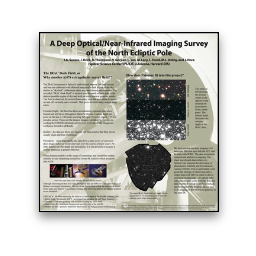The bias and dark current in the IRAC camera are calibrated by making highly dithered observations near the north ecliptic pole, which is the darkest region of the infrared sky. This same region has been reobserved for about a half-hour every one to two weeks since the Spitzer mission began. Over time this has integrated up to be one of the deepest observations ever made in the near-infrared over an area this size (15 arcminutes). It is also the longest blank-field time-series at these wavelengths.
In addition to the IRAC 3.6-8.0 micron data, there is also:
- Deep optical imaging from the Palomar 200-inch
- Optical spectroscopy from the Palomar 200-inch
- Near-IR imaging from Palomar and KPNO
- Near and mid-IR imaging and spectroscopy from Akari
- Deep Spitzer/MIPS 24-micron data.
- HST ACS I-band imaging
- Chandra deep imaging
- Synoptic optical data from the Palomar 60-inch and Palomar Transient Factory
Jessica Krick (then post-doc) and Mark Frost (student) did most of the real work so far. Several papers have been produced:
- Galaxy Clusters in the IRAC Dark Field. I. Growth of the Red Sequence, Krick et al., 2008, ApJ, 686, 918
- Galaxy Clusters in the IRAC Dark Field. II. Mid-Infrared Sources, Krick et al., 2009, 700, 123
- A Pilot Search for Population III Supernova Candidates in the Spitzer/IRAC Dark Field, Frost et al., 2009, ApJL, 698, L68
- The Infrared Array Camera Dark Field: Far-Infrared to X-ray Data, Krick et al., 2009, ApJS, 185, 85
I am currently planning a public data release, which is funded via a NASA ADP program. Stay tuned, or contact me. See "iracdarkfield.com".

